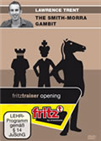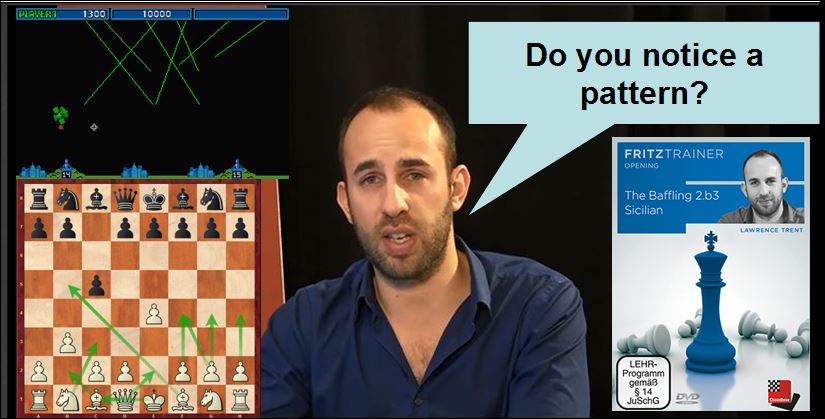A review
It's important to begin by making clear from the outset — as Lawrence Trent does — that 2.b3 is not going to refute the Sicilian or put its advocates out of business. But it is a useful addition to the arsenal of weapons we can use to disorient our opponents both in tournaments with long time controls, as well as blitz, or rapid rated games.
 What do you do against the Sicilian Defence? Do you play a mainline, safe in the knowledge that despite being the most reliable way to gain an opening advantage, you could be condemned to spending years studying a huge body of opening theory, or do you choose an Anti-Sicilian, a way to sidestep the mainlines at the risk of allowing Black to have a sneaking chance to achieve equality?
What do you do against the Sicilian Defence? Do you play a mainline, safe in the knowledge that despite being the most reliable way to gain an opening advantage, you could be condemned to spending years studying a huge body of opening theory, or do you choose an Anti-Sicilian, a way to sidestep the mainlines at the risk of allowing Black to have a sneaking chance to achieve equality?In fact, Trent already authored a pair of video series I studied previously and used in tournaments — one on the Smith-Morra, and the other on the Modern Grand Prix Attack. This last one, in particular, is quite good because it also teaches general principles of how to attack the kingside.
Another point made by Trent, with which I totally agree, is about piece placement. We play certain openings and we want to have our pieces in certain places because it works. But often an amateur player will fail to adapt to changes in the pawn structure or strategic plans and instead play on auto-pilot.
One more interesting argument put forth by Trent is about achieving an equal game. Yes, the b3 Sicilian is not a dazzling gambit where one combatant must inevitably go down in flames. But that's not the point.

Is this chess or space invaders?
So what's in it for us? Trent has done the research for us! Average club players just need to put in the time to study the material he found. In the beginning, Trent mentions GM Gelashvili, one of the main exponents of this opening in modern times. However, when I opened the database included with the video series, guess who I found? One of the most original thinkers in terms of opening novelties: Alexander Morozevich!
The Grand Prix Attack is one of White’s most enterprising weapons against the Sicilian Defence, and a favourite among club players and Grandmasters alike. This is an opening that must be treated with both caution and respect. Over the past few years Grandmaster Gawain Jones, arguably the world’s leading expert on the variation, has used the Grand Prix Attack to defeat a number of world class opponents, which demonstrates that underestimating its potential can cause casualties even at the highest level. This DVD will provide you with a comprehensive repertoire that explores all of Black’s ideas against the Grand Prix set up.
Morozevich's games are brilliant and worth watching. However, in the tournaments I play I'm not facing the elite opposition Morozevich typically encounters. So these games are less relevant to my praxis. Those played by Gelashvili, however, are definitely appropriate for my level! For example, the first one, against Drinovec: By move 20 Black has four pawn islands, an exposed king and has not yet finished his development.
Watching the games of these two important practitioners of the b3 Sicilian is quite interesting because one can get a feel for the different approaches and different interpretation of the opening.
Now we have seen the games, let's go to see what Trent is teaching! He begins showing the piece development and attacks we can have with this type of Sicilian using some illustrative diagrams:

 On this DVD IM Trent shows the Albin Counter-Gambit (1.d4 d5 2.c4 e5). Trent found a number of extremely dangerous Theoretical Novelties which will truly put the Albin Counter-Gambit back on the map.
On this DVD IM Trent shows the Albin Counter-Gambit (1.d4 d5 2.c4 e5). Trent found a number of extremely dangerous Theoretical Novelties which will truly put the Albin Counter-Gambit back on the map.One doesn't play this type of Sicilian to get +3 engine evaluation after 12 moves. Rather, play and study this type of Sicilian with the idea of bringing the opponent out of opening theory and into a playable middlegame to prove which of the two players can better leverage imagination, pattern recognition and long-term planning skills. Yes, go play that weekend tournament without worrying about setting aside enough time to learn opening theory and instead focus more on learning middlegame ideas.
Trent begins the videos by showing rare second moves Black can play. Often when our opponents face a new move, they will respond with something strange, making us think they are prepared when they are not.
I have found often, including after training via opening videos, that once I'm at the board I forget how to continue in some line or another. Here I'd like to give some examples one can play against the engine to help you conquer this problem.
For instance, after the moves 1.e4 c5 2.b3 d5 (challenging White in the centre immediately!) 3.exd5 Qxd5 4.Nc3 Qe5 5.Be2 Bg4, how should White continue?
Trent also presents some interesting novelties — improvements over the games of previous GMs — as I mentioned, he did the homework for us. I'm going to give one such novelty, but without explaining it in full as he does in the video series. After all, I don't want to reveal all his analysis! Try to play it, and then once you buy the full series, you can discover if you reached the same conclusions:
1.e4 c5 2.b3 d5 3.exd5 Qxd5 4.Nc3 Qd6 (a hint to better appreciate Trent's homework: this can seem a Scandinavian with Qd6, like Tiviakov likes to play, but the c-pawn on c5 instead of c6 which makes a huge difference!) 5.Nf3 Nf6 6.d4!?
The novelty — after Black plays 6...cxd4 how should White continue?
Also, even if Trent has done the homework for us, we do need to practice many of the positions and be sure we are up to the task in a real game.
In this case, Trent says White has a good endgame. While he surely knows how to win it, for many of us could be a problem. But thanks to ChessBase we can go ahead and practice.
And then, of course, there are more quiet positions, where White just has a slight initiative. One must play such positions to discover plans and ideas before a tournament game. In this position, after 14.f5 White has the initiative, try to see how to continue against the engine:
While the b3 Sicilian is about opening with the queenside fianchetto, we must never forget that the appropriate development of the c1-bishop is based upon some important positional concerns. If there is a chance to open the c1-h6 diagonal thanks to the pawn push f2-f4, then one must consider keeping the bishop on c1, instead of automatically developing it to b2. The following position is reminiscent of the Grand Prix, or King's Gambit and definitely is interesting for a possible kingside attack.
What's in the video series?
There are nearly six hours of videos. The database of model games has 94 games. And there are 14 videos of quizzes, where Trent shows a position, and we must find the right move, or remember the explanations given in the videos, to know how to continue.
Final thoughts
Growth begins at the edge of our comfort zone. If we really want to grow as chess players, then trying something new and having the courage to play it in tournaments, even if just for a few months, can have lasting consequences in our quest for chess improvement and help bring us to the next stage. Our opponents will also be awestruck to find someone who is always ready to take them out of their comfortable Sicilian terrain. They will be prone to blunder and you may notice a lingering aura of invincibility made possible by hard studying, yes, but also from not being afraid of going down new paths.
Make life difficult for the Sicilian! 2.b3 is a thoroughly venomous but still solid kind of "Anti-Sicilian". No matter what setup black chooses, the bishop on b2 will always be unpleasant for him.
Links
























